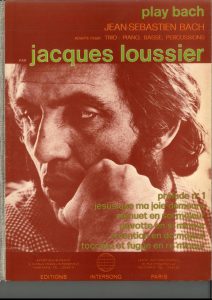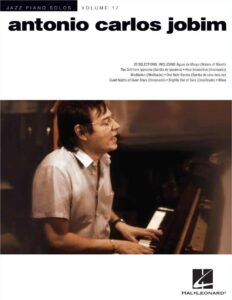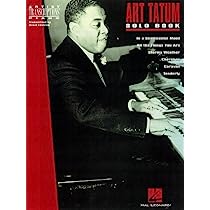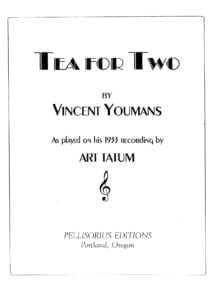Bach meets Jazz – Jacques Loussier plays BACH
Subscribe & download the best scores and sheet music transcriptions from our Library.

Jacques Loussier
Jacques Loussier (26 October 1934 – 5 March 2019) was a French pianist and composer. He arranged jazz interpretations of many of the works of Johann Sebastian Bach, such as the Goldberg Variations. The Jacques Loussier Trio, founded in 1959, played more than 3,000 concerts and sold more than 7 million recordings—mostly in the Bach series.
Loussier composed film scores and a number of classical pieces, including a Mass, a ballet, and violin concertos. Loussier’s style is described as third stream, a synthesis of jazz and classical music, with an emphasis on improvisation.
Browse in the Library:
| Artist or Composer / Score name | Cover | List of Contents |
|---|---|---|
| Antonio Carlos Jobim – Luiza Guitar Arr with Tablature |
 |
|
| Antonio Carlos Jobim – One Note Samba (Guitar Arr.) |
 |
|
| Antonio Carlos Jobim – One Note Samba (guitar TABS sheet music) | Jobim – One Note Samba (guitar TABS sheet music) | |
| Antonio Carlos Jobim – Samba De Uma Nota So | ||
| Antonio Carlos Jobim – Se Todos Fossem Iguais A Voce arr. by Baden Powell (Guitar arr. sheet music with TABs) | Antonio Carlos Jobim – Se Todos Fossem Iguais A Voce arr. by Baden Powell (Guitar arr. sheet music with TABs) | |
| Antonio Carlos Jobim – Tom Jobim For solo Guitar with TABs |
 |
Tom Jobim for Solo Guitar |
| Antonio Carlos Jobim – Triste (Guitar Solo Arr. With Tabs Sheet Music) (Musescore File).mscz | ||
| Antonio Carlos Jobim 9 Pieces Guitar TABs |
 |
Jobim 9 pieces guitar |
| Antonio Carlos Jobim And Chico Buarque Eu Te Amo (Arr. For Guitar By Carles Trepat) |
 |
|
| Antonio Carlos Jobim and the art of Bossa Nova Jazz Play Along Volume 08 with audio MP3 |
 |
Antonio Carlos Jobim Jazz Play-Along Volume 08 – with audio MP3_compressed |
| Antonio Carlos Jobim Anthology (Piano vocal and guitar) |
 |
Antonio Carlos Jobim Anthology (Piano vocal and guitar) |
| Antonio Carlos Jobim for Classical Guitar (Paulo Bellinati Mel Bay 2008) |
 |
Antonio Carlos Jobim for Classical Guitar |
| Antonio Carlos Jobim Jazz Piano solos Vol. 17 |
 |
Antonio Carlos Jobim Jazz Piano solos Vol. 17 sheet music pdf |
| Antonio Carlos Jobim Jazz Play Along Vol. 08 with audio MP3 |
 |
Antonio Carlos Jobim Jazz Play-Along Volume 08 – with audio MP3_compressed |
| Antonio Carlos Jobim Quebra Pedra (Stone Flower) – Tom Jobim Piano and Guitar chords |
 |
|
| Antonio Carlos Jobim Stone Flower (Songbook) Quebra-pedra Tom Jobim Piano Vocal guitar Chords |
 |
Antonio Carlos Jobim Stone Flower (Songbook) Tom Jobim Piano Vocal guitar Chords |
| Antonio Carlos Jobim Tom Jobim – Luiza Guitar Solo |
 |
|
| Antonio Carlos Jobim Tom Jobim Corcovado arr. for Guitar Violao by Rubinho | Antonio Carlos Jobim Tom Jobim Corcovado arr. for Guitar Violao by Rubinho | |
| Antonio Carlos Jobim Wave (Piano Guitar) |
 |
Antonio Carlos Jobim Wave (Piano Guitar) |
| Anywhere the heart goes (The Thorn birds – Uccelli di rovo) | ||
| Aphex Twin – aisatsana |
 |
|
| Aphex Twin – Avril 14th |
 |
|
| Aphex Twin – Avril 14th (Musescore File).mscz | ||
| Aphex Twin – Kesson Daslef |
 |
|
| April In Paris Vernon Duke E.Y. Harburg 1932 Jazz Standard (Vintage sheet music) |
 |
|
| Aqua – Doctor Jones | ||
| Aquaman Everything I Need Skylar Grey Piano solo |
 |
|
| Aram Khachaturian – Sabeltanz Aus Gayaneh (Pianoforte 4 hands) | Aram Khachaturian – Sabeltanz Aus Gayaneh (Pianoforte A 4 Mani) | |
| Aranjuez Ma Pensee (ver. for voice and guitar by the composer) |
 |
Aranjuez Ma Pensee |
| Aretha Franklin – Chain Of Fools | ||
| Aretha Franklin – Respect | ||
| Aretha Franklin Songbook |
 |
Aretha Franklin Songbook |
| Aretha Franklin Songbook 1 |
 |
Aretha Franklin Songbook 1 |
| Aretha Franklin Songbook 2 |
 |
Aretha Franklin Songbook 2 |
| Aretha Franklin The Very Best of The 60s |
 |
Aretha Franklin best of 60s |
| Ari Hoenig Songbook |
 |
Ari Hoenig Songbook |
| Ari Pulkkinen – Angry Birds Theme Song | Ari Pulkkinen – Angry Birds Theme Song | |
| Aria (Cantilena) by Heitor Villa-Lobos.mscz | ||
| Aria di neve (Sergio Endrigo) | ||
| Ariana Grande – 7 Rings Sheet Music |
 |
|
| Ariana Grande – Bang Bang Sheet Music piano Vocal Guitar chords |
 |
|
| Ariana Grande – No Tears Left to Cry Sheet Music |
 |
|
| Ariana Grande Tattooed Heart | Ariana Grande-Tattooed heArt | |
| Ariel Ramírez – Alfonsina Y El Mar (Guitar) arr. by Roland Dyens | Ariel Ramírez – Alfonsina Y El Mar (Guitar) arr. by Roland Dyens | |
| Ariel Ramírez – Alfonsina Y El Mar (Piano) | Ariel Ramírez – Alfonsina Y El Mar (Piano) | |
| Arlen, Harold Stormy weather – piano | Stormy weather – piano | |
| Armageddon (Piano & Guitar Chords) |
 |
Armageddon (Piano & Guitar Chords) |
| Arnold Schoenberg, Gerald Strang, Leonard Stein-Fundamentals of Musical Composition-Faber & Faber (1982) Book |
 |
|
| Around The Campfire Peter, Paul and Mary – Guitar songbook |
 |
Around The Campfire Peter Paul & Mary songbook |
| Arpeggios For The Modern Guitarist Tabs by Will Johnson |
 |
Arpeggios For The Modern Guitarist Tabs by Will Johnson |
| Arranging And Composing for the small ensemble Jazz R&B Jazz-Rock (by David Baker) |
 |
|
| Arrival Of The Birds from The Crimson Wing Mystery of the Flamingos piano solo |
 |
|
| Arrival Of The Birds The Theory of Everything – The Cinematic Orchestra Piano Solo |
 |
|
| Arrival Of The Birds The Theory of Everything Ending Scene Music – The Cinematic Orchestra Piano Solo |
 |
|
| Art Blakey And The Jazz Messanger Bobby Timmons – Moanin’ |
 |
|
| Art Of Composing Music (Published In London (1751) |
 |
|
| Art Of Gospel Guitar – El McMeen with Tablature |
 |
Gospel guitar |
| Art of Jazz improvisation book 3 Intermadiate by Bob Taylor |
 |
|
| Art Pepper Collection Solos Artist Transcriptions Saxophone |
 |
art pepper solos sheet music |
| Art Tatum As Time Goes By |
 |
|
| Art Tatum – Tiger Rag (Jazz Standard by the Original Dixieland Jass Band) (piano sheet music) | Art Tatum – Tiger Rag (Jazz Standard by the Original Dixieland Jass Band) (piano sheet music) | |
| Art Tatum – All The Things You Are |
 |
|
| Art Tatum – Cherokee |
 |
|
| Art Tatum – Gershwin – The Man I Love (Piano as played by) | Art Tatum Gershwin The-Man-I-Love-Piano | |
| Art Tatum – Jazz Piano solos Vol. 2 |
 |
Art Tatum Jazz piano solos vol. 2 |
| Art Tatum – New Beginnings A Piano Imrovisation | Art Tatum – New Beginnings A Piano Imrovisation | |
| Art Tatum – Tea For Two (Sheet Music) (Musescore File).mscz | ||
| Art Tatum – Tiger Rag (Sheet Music) (Musescore File).mscz | ||
| Art Tatum – Too Marvelous for Words The Life and Genius of Art Tatum (Book by James Lester) |
 |
|
| Art Tatum 5 Jazz Piano Solos transcribed By Frank Paparelli |
 |
Art Tatum 5 Jazz Solos By Frank Paparelli – 1944 Songbook |
| Art Tatum Artist Transcriptions Solo Book |
 |
Art Tatum |
| Art Tatum Improvisations Piano sheet music |
 |
Art Tatum Improvisations Piano sheet music |
| Art Tatum Jazz Arr. Begin The Beguine (Musescore File).mscz | ||
| Art Tatum Jazz Arr. Cole Porte Begin The Beguine |
 |
|
| Art Tatum New Beginnings (Musescore File).mscz | ||
| Art Tatum Stormy Weather Ted Koehler – Harold Arlen | T.Koehler-H.Arlen – Stormy Weather (arr. A.Tatum) | |
| Art Tatum Tea For Two (Vincent Youmans) |
 |
|
| Arthur A. Reblitz – Piano servicing, tuning, and rebuilding for the professional, the student, and the hobbyist |
 |
|
| Artic Monkeys – Only Ones Who Know | ||
| Artie Shaw – Jazz Technic Book 1 Scales and Exercises |
 |
Artie Shaw – Jazz Technic Book 1 Scales and Exercises |
| Artie Shaw – Clarinet Method |
 |
|
| Artie Shaw – Concerto for Clarinet for solo Bb Clarinet with Piano accompaniment |
 |
|
| Artie Shaw – Moonglow Clarinet sheet music |
 |
|
| Artie Shaw His Life And Music by John White (Book) Biography |
 |
|
| Artpop Lady Gaga Songbook |
 |
|
| Arturo Sandoval – Sandunga Alto Sax | Arturo Sandoval – Sandunga Alto Sax | |
| Arturo Sandoval – Trumpet Method |
 |
|
| Arvo Part Fratres Piano Sheet music |
 |
|
| Arvo Pärt Partita For Piano, Op 2 (1960) |
 |
|
| Arvo Pärt Spiegel Im Spiegel (Violoncello And Piano) |
 |
|
| Arvo Part Summa for Strings | Arvo Part Summa for Strings | |
| Arvo Part – Fur Alina Variations | Arvo Part – Fur Alina Variations | |
| Arvo Pärt – Zwei Sonatinen Für Klavier Op. 1 |
 |
|
| Arvo Pärt Out Of Silence (Peter C. Bouteneff) Book |
 |
|
| Arvo Pärt Sounding The Sacred Book by Peter C. Bouteneff Jeffers Engelhardt Robert Saler |
 |
|
| Arvo Pärt Spiegel Im Spiegel (arranged for Piano Solo) | Arvo Pärt – Spiegel Im Spiegel (arranged for Piano Solo) | |
| Arvo Pärt Spiegel Im Spiegel Violin Piano |
 |
|
| Ary Barroso – Amor Fatal Fox triste (piano) |
 |
|
| Ary Barroso – Aquarela Do Brasil (Samba) Guitar Solo |
 |
|
| Ary Barroso – Aquarela Do Brasil (Samba) Guitar Solo TABs |
 |
|
| Ary Barroso – Aquarela Do Brasil (Samba) Guitar Solo.mscz | ||
| Ary Barroso – Aquarela do Brasil Piano Vocal | Ary Barroso-Aquarela do Brasil | |
| Ary Barroso – Tenho Saudade! Samba Cançao (piano) |
 |
|
| Ary Barroso Aquarela Do Brasil Arr Carlos Barbosa Lima for guitar | Ary Barroso Aquarela Do Brasil Arr Carlos Barbosa Lima for guitar | |
| Ary Barroso Guitar 1 songbook (arr. by Almir Chediak) |
 |
Ary Barroso Guitar 2 songbook (arr. by Almir Chediak) |
| Ary Barroso Guitar 2 songbook (arr. by Almir Chediak) |
 |
Ary Barroso Guitar 2 songbook (arr. by Almir Chediak) |
| As 101 Melhores Canções Do Século XX – Vol 2 – Almir Chediak (Guitar) |
 |
As 101 Melhores Canções Do Século XX – Vol 2 |
| As 101 melhores cançoes do século XX Vol. 1 (Almir Chediak) |
 |
As 101 Melhores Canções Do Século XX – Vol 2 |
| As Time Goes By (Musescore File).mscz | ||
| Ashanti – The Way That I Love | ||
| Asking you (Green Card OST) Hans Zimmer | ||
| Assassin’s Creed Rogue – Main Theme |
 |
|
| ASSASSINS – The Musical Sondheim-Weidman (Piano & Vocal) |
 |
ASSASSINS – The Musical Sondheim-Weidman (Piano & Vocal) |
| Assassins Creed 2 – Ezios Family |
 |
|
| Assassins Creed III Main Theme |
 |
|
| Astor Piazolla – Adios Nonino | ||
| Astor Piazolla Libertango Violin And Piano | Astor Piazolla Libertango Violin And Piano | |
| Astor Piazzola – Libertango (piano arr.) |
 |
|
| Astor Piazzola – Libertango (Piano Solo) |
 |
|
| Astor Piazzola – Play Piazzolla 13 Tangos By Astor Piazzolla EASY GUITAR ARR. |
 |
Astor Piazzola – Play Piazzolla 13 Tangos By Astor Piazzolla EASY GUITAR ARR. |
When Loussier began applying jazz improvisation and swing to Johann Sebastian Bach’s exquisite symmetries, some jazz pundits and fans dismissed it as a betrayal of an African-American music’s expressive earthiness and blues roots, aimed at an audience that preferred its jazz pretty rather than passionate. And from the classical angle, observers were liable to perceive the young Frenchman’s work as little short of vandalism.
The New York Times critic John Rockwell’s review of a Loussier concert at Carnegie Hall in 1975 reflected that distaste when he proclaimed: “There is a certain sort of sensibility that is actively appalled by the very notion of ‘popularising’ Bach – or any classical composer, for that matter. This listener’s sensibility is one of those, and so he found the Tuesday evening performance at a sparsely attended Carnegie Hall by the Jacques Loussier Trio tiresome and offensive.”
Nonetheless, the success of concerts and recordings by Loussier and his Play Bach trio (originally formed with the eminent Paris jazz sidemen Pierre Michelot on bass and Christian Garros on drums) took off almost overnight from the group’s first appearances in 1959 – shifting millions of Play Bach recordings in the almost two-decade life of the original band.
The group’s suitably chilled-out, languidly hip treatment of Bach’s Air on the G String famously accompanied the Hamlet cigar company’s TV advertising from 1962, with cinema versions finally being banned at the end of the century, though these soundtracks did not include Michelot’s subsequent driving bass-walk and Loussier’s freewheeling improv theme-stretches.
Loussier, however, was no one-trick populist who had chanced on a hit formula and milked it. A piano virtuoso from early childhood, he attended the Conservatoire National de Musique in Paris from his mid-teens under a celebrated mentor – the classical pianist and educator Yves Nat – travelled in the Middle East and Latin America absorbing musical ideas in his early 20s, and composed scores for more than 60 films and TV shows. There was also the tireless touring of the Play Bach trio – and after its breakup, he worked on both acoustic and electronic projects at his own Studio Miraval in Provence.
Born in Angers, in western France, Loussier began piano lessons at the age of 10, and within a year was fascinated by the music of Bach. When he heard a piece from the Notebook for Anna Magdalena at 11, he took to playing it incessantly. “I was studying this piece and I just fell in love with it,” Loussier told an interviewer in 2003. “Then I found I loved to play the music, but add my own notes, expanding the harmonies and playing around with that music.”
In this, as Loussier was later to observe, he was not subverting Bach but paying his respects to an improvising tradition to which the composer also belonged, even if classical music’s subsequent assumptions preferred to bury that unruly element.
Loussier’s potential had been brought to Nat’s attention when he was 13, and Nat supplied him with practice projects that the boy would visit Paris every three months to demonstrate. At 16 he entered the conservatoire, financing his courses by playing jazz in the city’s bars.
In the mid-1950s Loussier then took off on his travels, which included Cuba, where he stayed for a year. Back home, he found work as an accompanist, to the singer and actor Catherine Sauvage and Charles Aznavour.
Loussier later recalled that in 1959 he had told Decca Records that he was a classical pianist and they said they already had plenty. Then he said he was a jazz pianist and they said they had plenty of those, too. “Finally I started to play some Bach with my improvisations and they said, ‘What is that? Why don’t we make a record of that?’ I was still doing it out of fun. I never thought the public would like it. I was wrong.”
With Michelot and Garros, and with the American chamber-musical Modern Jazz Quartet as a significant and celebrated inspiration, the Play Bach trio made four hugely successful Decca albums between 1960 and 1963, launched a performance schedule rarely numbering fewer than 150 shows a year worldwide, and expanded the repertoire to include double-tracked recordings of Loussier parts on organ and piano, and arrangements of Bach concertos.
In the midst of it all, Loussier was also a sought-after composer for film and TV. In 1978, weary of travelling, he wound the trio up and retired to Studio Miraval to explore composition more deeply, experiment with electronics and studio techniques, and play host and offer recording time to visiting rock stars including Pink Floyd, AC/DC and Sade.
He wrote the full-scale symphony Lumières (with the countertenor James Bowman, soprano Deborah Rees and a rock rhythm section on its Paris premiere), concertos for trumpet and violin, strings suites, a ballet score and the crossover fusion works Pulsion, Pagan Moon, and Pulsion Sous la Mer.

But Bach’s 1985 tercentenary had already tempted Loussier back to the piano stool. With the jazz/classical bassist Vincent Charbonnier, followed after illness in the 90s by the comparably virtuosic Benoit Dunoyer de Segonzac and the percussionist André Arpino, Loussier formed a more broadminded, genre-fluid and technically sophisticated version of the Play Bach trio, which if anything amplified just how creatively musical his original vision had been.
Recording for Telarc from 1996, Loussier returned to his beloved Bach, explored Vivaldi’s Four Seasons in improv conversations with Charbonnier and Arpino, with an affectionate nod to the Modern Jazz Quartet’s Django (1997), and Satie, with De Segonzac and Arpino (1998).
Interpretations of Ravel, Beethoven, Mozart and Chopin followed (with the last-named occasioning Loussier’s first solo piano album in his 70th birthday year, on which he breezily threw flamenco, gospel, calypso and stride-piano into the mix), and ambitious Bach homages taking on the Goldberg Variations and the Brandenburg Concertos.
In 2002, the pianist’s life took an unlikely turn when he embarked on a lawsuit against the rapper Eminem for allegedly stealing hooks from Pulsion for the track Kill You from the Marshall Mathers LP – a confrontation eventually settled out of court. In a conversation that year with the writer Sholto Byrnes, Loussier seemed mainly miffed that the Americans had not asked him first, and typically claimed: “I like good music whatever it is.” He later registered an interest in Eminem’s music.
Jazz reference books have not been so generous to Loussier, but, a true jazz improviser rather than an embellisher of the classics, he sidelined the snobberies from both sides in his early years. He paid tribute to the composers he loved with unmistakable and expert devotion, performing long enough to see his inclusive vision of a music with far fewer borders come to pass.
